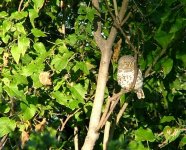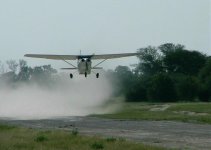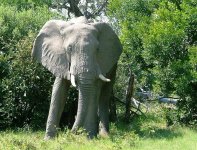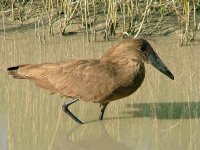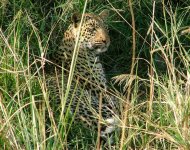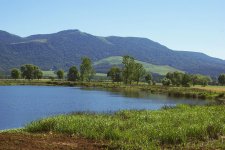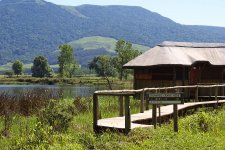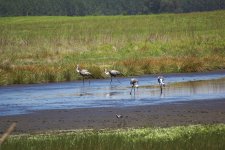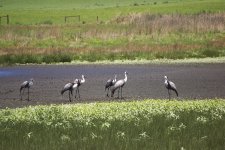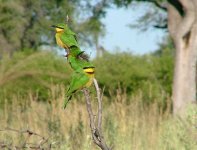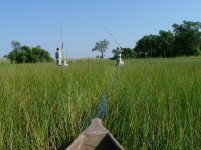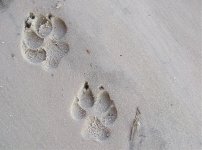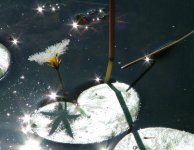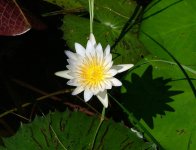-
Welcome to BirdForum, the internet's largest birding community with thousands of members from all over the world. The forums are dedicated to wild birds, birding, binoculars and equipment and all that goes with it.
Please register for an account to take part in the discussions in the forum, post your pictures in the gallery and more.
You are using an out of date browser. It may not display this or other websites correctly.
You should upgrade or use an alternative browser.
You should upgrade or use an alternative browser.
Southern African Forum (11 Viewers)
- Thread starter Dave Kennedy
- Start date
More options
Who Replied?Sal
Well-known member
Off to Botswana tomorrow! Can't wait!
Woohoo Kittykat - have a wonderful time. Dont forget to tell us about it when you get back!
Dave Kennedy
Well-known member
Off to Botswana tomorrow! Can't wait!
Hey, KK........
Have a fabulous trip! Can't wait to hear all about it. I expect - at the bare minimum - Pels Fishing Owl, Slaty Egret, Dickinson's Kestrel, Wattled Crane, Barred Owlet, Brown Firefnch, Rosy-throated Longclaw, Brown-throated Weaver, Rufous-bellied Heron, Swamp Boubou.......
These are the easy ones.....you might also keep a lookout for Western Banded Snake Eagle, Collared Palm Thrush (especially on Chobe/Zambezi), Bradfield's Hornbill, Carmine Bee-eater, Kori Bustard, Red-winged and Rock Pratincole (also up on Chobe/Zambezi), Retz's Helmet-shrike, Long-toed Lapwing.......
Don't forget the lions/leopards/buffalo/elephant/hippos/crocs etc. You don't meet them when you're birdwatching at Cley. And if you really want some fun, get onto a mokoro (canoe) in the Delta and ask to see the tiny Painted Reed Frogs and the various waterlilies and other aquatic plants -they make fascinating subjects for photography.
With very best wishes,
Dave Kennedy
Dave Kennedy
Well-known member
Hey, KK........
Don't forget the lions/leopards/buffalo/elephant/hippos/crocs etc. You don't meet them when you're birdwatching at Cley. And if you really want some fun, get onto a mokoro (canoe) in the Delta and ask to see the tiny Painted Reed Frogs and the various waterlilies and other aquatic plants -they make fascinating subjects for photography.
KK,
Here's 5 of the Delta's finest to get you in the mood.
Dave
Attachments
Sal
Well-known member
I have just been to a place on the Midlands Briding Route (Southern KZN Birding Route) that I have never visited before. It only opened last year and hosts the Karkloof Conservation Centre. If you drive through Howick and find the SupaQuick tyre shop, you can easily find it. Turn right at the robot at the tyre shop onto the Karkloof road and travel for 15.5km. There, on your right is an avenue of plane trees and a big notice saying Karkloof Conservation Centre and another one saying Gartmore farm. Bear to the right as you turn in, and you will find a car park. There is an entrance fee of R20/person and for that you have access to two bird hides, a small picnic area and a toilet. The bird hides are less than a km from the office and picnic site - about a 2km walk to do the round trip. They also have a golf cart and will take people to the hides in this if you cant walk too well!
The hides are very well built, roomy, with sloping concrete roofs that keep the inside relatively cool. The Crowned Crane Hide has a large tinted glass window behind which are three comfortable camping chairs. There are also several shutters that open along the lengths and large sawn-off tree trunks to sit on. As we walked down to the first hide we saw Stonechats, Black Crows, Black-capped Bulbuls, Pintailed Whydas and Fork-tailed Drongos. There is a small dead tree just outside the hide, and once we were in, an African Fish Eagle flew to it, but was then disturbed by someone's movement and flew off to a more distant tree. There was a Spurwing Goose on the side of the dam, later joined by three more, and a Pied Kingfisher that was fishing from the small dead tree and eventually caught such a large fish for its size that after beating it into submission on a branch, flew around with it for ages perching on branches and rocks, seeming not to know quite what to do with it! On the far side of the dam a Grey Heron was quietly fishing and in the reeds and the ryegrass to the side of the hide were masses of Euplectesamongst which were many Southern Red Bishops in partial breeding plumage together with masses of drab females, Long-tailed Widowbirds, Red-collared Widowbirds and Fan-tailed Widowbirds. Little Rush Warblers could be seen amongst them and Cape Wagtails were everywhere as were Blacksmith Lapwings . Some Egyptian Geese flew in, and overhead Yellow-billed Kites wheeled. Three Hammerkops then came in and landed on the side of the dam nearest the hide and gave us a mating display. The best sighting of the morning was two Grey Crowned Cranes that flew slowly across the dam on their way to feed in the fields. Lovely. We then walked to the second hide. There was very little water in this dam and all that it yielded was another Grey Heron, lots more Blacksmith Lapwings and several Fiscal Shrikes hawking from a branch close to the hide. One of them was feeding a most insistent fledgling which was still learning to judge distances for landing - it crashed from one branch to another and we had a hard time keeping our laughter muted. There were also Yellow-fronted Canaries both here and on our walk back which was enlivened by the agressive, noisy Pin-tailed Whydas many of which which are in breeding plumage now, several more Cape Wagtails and masses of Village Weavers busy building nests in a large London Plane.
We had tea at the picnic site and then someone went to fetch something from the car - and locked the keys in the boot. In the boot also were our mobiles and the spare car keys . . . . This car is not easy to break into and the keys are coded. Eventually we found a locksmith who was willing to drive up into the sticks for us but he said he would be at least two hours. As it happened, this was the luckiest break, because whilst we were lolling about on the grass I saw two Wattled Cranes flying over! For anyone who does not know this, the Wattled crane is endemic to Southern Africa and an endangered species down here. There are approximately 220 left. Of these, 60 are still juveniles (it takes the seven years to reach maturity and during this time, after the first year spent with their parents, they tend to stay together in a group). Then there are 80 pairs (they pair for life) who leave the young after the first year.
I shouted to the guy in the office and he came out. We watched them flying in the direction of the second dam, so he got out the golf cart and we went careering down the farm road to the turn-off to the second hide. And when we got there - not two but NINE Wattled Cranes! We watched them for the next hour as they fed, preened rested and interacted; it was amazing. I have seen them before, about ten km from this farm, but that time I only saw two and they were further away. Then we had to leave to get back to meet the locksmith and I am happy to report that half an hour and R400 later, we were able to drive off and find some lunch!
I have attached a couple of pics below showing the first hide and the dam and the wattled cranes (although we were not close enough and I do not have a sufficiently powerful lens to get good pics).
The hides are very well built, roomy, with sloping concrete roofs that keep the inside relatively cool. The Crowned Crane Hide has a large tinted glass window behind which are three comfortable camping chairs. There are also several shutters that open along the lengths and large sawn-off tree trunks to sit on. As we walked down to the first hide we saw Stonechats, Black Crows, Black-capped Bulbuls, Pintailed Whydas and Fork-tailed Drongos. There is a small dead tree just outside the hide, and once we were in, an African Fish Eagle flew to it, but was then disturbed by someone's movement and flew off to a more distant tree. There was a Spurwing Goose on the side of the dam, later joined by three more, and a Pied Kingfisher that was fishing from the small dead tree and eventually caught such a large fish for its size that after beating it into submission on a branch, flew around with it for ages perching on branches and rocks, seeming not to know quite what to do with it! On the far side of the dam a Grey Heron was quietly fishing and in the reeds and the ryegrass to the side of the hide were masses of Euplectesamongst which were many Southern Red Bishops in partial breeding plumage together with masses of drab females, Long-tailed Widowbirds, Red-collared Widowbirds and Fan-tailed Widowbirds. Little Rush Warblers could be seen amongst them and Cape Wagtails were everywhere as were Blacksmith Lapwings . Some Egyptian Geese flew in, and overhead Yellow-billed Kites wheeled. Three Hammerkops then came in and landed on the side of the dam nearest the hide and gave us a mating display. The best sighting of the morning was two Grey Crowned Cranes that flew slowly across the dam on their way to feed in the fields. Lovely. We then walked to the second hide. There was very little water in this dam and all that it yielded was another Grey Heron, lots more Blacksmith Lapwings and several Fiscal Shrikes hawking from a branch close to the hide. One of them was feeding a most insistent fledgling which was still learning to judge distances for landing - it crashed from one branch to another and we had a hard time keeping our laughter muted. There were also Yellow-fronted Canaries both here and on our walk back which was enlivened by the agressive, noisy Pin-tailed Whydas many of which which are in breeding plumage now, several more Cape Wagtails and masses of Village Weavers busy building nests in a large London Plane.
We had tea at the picnic site and then someone went to fetch something from the car - and locked the keys in the boot. In the boot also were our mobiles and the spare car keys . . . . This car is not easy to break into and the keys are coded. Eventually we found a locksmith who was willing to drive up into the sticks for us but he said he would be at least two hours. As it happened, this was the luckiest break, because whilst we were lolling about on the grass I saw two Wattled Cranes flying over! For anyone who does not know this, the Wattled crane is endemic to Southern Africa and an endangered species down here. There are approximately 220 left. Of these, 60 are still juveniles (it takes the seven years to reach maturity and during this time, after the first year spent with their parents, they tend to stay together in a group). Then there are 80 pairs (they pair for life) who leave the young after the first year.
I shouted to the guy in the office and he came out. We watched them flying in the direction of the second dam, so he got out the golf cart and we went careering down the farm road to the turn-off to the second hide. And when we got there - not two but NINE Wattled Cranes! We watched them for the next hour as they fed, preened rested and interacted; it was amazing. I have seen them before, about ten km from this farm, but that time I only saw two and they were further away. Then we had to leave to get back to meet the locksmith and I am happy to report that half an hour and R400 later, we were able to drive off and find some lunch!
I have attached a couple of pics below showing the first hide and the dam and the wattled cranes (although we were not close enough and I do not have a sufficiently powerful lens to get good pics).
Attachments
Last edited:
Dave Kennedy
Well-known member
KK,
Here's 5 of the Delta's finest to get you in the mood.
Dave
Especially for you, KK...........5 more.
Dave K
Attachments
Dave Kennedy
Well-known member
I have just been to a place on the Midlands Briding Route (Southern KZN Birding Route) that I have never visited before. It only opened last year and hosts the Karkloof Conservation Centre.
As it happened, this was the luckiest break, because whilst we were lolling about on the grass I saw two Wattled Cranes flying over!
I shouted to the guy in the office and he came out. We watched them flying in the direction of the second dam, so he got out the golf cart and we went careering down the farm road to the turn-off to the second hide. And when we got there - not two but NINE Wattled Cranes!
Thanks for this, Sal, I didn't know about this place. Sounds great.
And congrats on the wattled Cranes! What a sighting! Not sure of the details, but I think there is an organisation monitoring Wattled Cranes. If you can find them I am sure they would welcome your information. I have seen Wattled Cranes intermittently on the Belfast-Dullstroom-Lydenburg road, but not for the last couple of years.
Best wishes,
Dave
Sal
Well-known member
Wattled Cranes
Yes Dave there is an organisation doing this; the Karkloof Conservancy collects data for them and will send it off. One of the cranes was banded too so it should be qite a helpful sighting. A serious attempt has been made to increase the numbers by taking the second egg from the nest, and then bringing up the chick without imprinting until it is old enough to be put back into the pool of 60. This has been going on for seven years and apparently has only resulted in nine chicks being successfully returned to the wild. One of the problems is that the egg can only be removed something like 24 hours before the older egg hatches otherwise the birds abandon the nest - as can be imagined, not an easy time to compute. Not so much of a problem with providing ideal hatching conditions, so there are quite a number of successful hatchings, but then after that there is a high mortality rate amongst the young chicks.
Thanks for this, Sal, I didn't know about this place. Sounds great.
And congrats on the wattled Cranes! What a sighting! Not sure of the details, but I think there is an organisation monitoring Wattled Cranes. If you can find them I am sure they would welcome your information. I have seen Wattled Cranes intermittently on the Belfast-Dullstroom-Lydenburg road, but not for the last couple of years.
Best wishes,
Dave
Yes Dave there is an organisation doing this; the Karkloof Conservancy collects data for them and will send it off. One of the cranes was banded too so it should be qite a helpful sighting. A serious attempt has been made to increase the numbers by taking the second egg from the nest, and then bringing up the chick without imprinting until it is old enough to be put back into the pool of 60. This has been going on for seven years and apparently has only resulted in nine chicks being successfully returned to the wild. One of the problems is that the egg can only be removed something like 24 hours before the older egg hatches otherwise the birds abandon the nest - as can be imagined, not an easy time to compute. Not so much of a problem with providing ideal hatching conditions, so there are quite a number of successful hatchings, but then after that there is a high mortality rate amongst the young chicks.
Hi allDamien, here's a few thoughts about Kruger to get the ball rolling.
Birding in the Kruger National Park (KNP) is superb. On a safety note, you may not get out of your vehicle except in the various rest camps, at picnic sites, at bird hides and at certain view sites. You can drive yourself around, so you are in no way dependent on a guide who is trying to find the Big Five for his clients. The best birding is often in the rest camps themselves, for there the birds have become used to people, and allow close approach. The same applies at picnic sites, where you can get out of your car, rent a gas cylinder for a few rand, and cook your breakfast, should you so wish. There are also excellent hides in certain areas of the park. There is a good one near Skukuza, the main camp, which is first class for water birds.
The park is broadly split into different habitats……..
1) North of Olifants Restcamp the vegetation is largely mopane veld (Colophospermum mopane), much favoured by elephant. We have always found birding in and around the Letaba rest camp to be particularly good. Both Olifants and Letaba have riverine frontage, which boosts the variety of birds significantly. Olifants is situated high on a cliff, affording spectacular views.
2) In the far north, the sandveld around Punda Maria yields many unusual tropical species, including Black-fronted Bush-shrike, and up around the Luvuvhu River to the north you can find Bohm’s and Mottled Spinetails.
3) South of Olifants the vegetation is principally Acacia thornveld, which has a good bird population. Bird parties in such habitat may yield different waxbills such as blue and violet eared waxbills, finches such as green-winged pytilia and firefinches, and beautiful starlings like the greater blue-eared glossy starling.
4) The area near Berg-en-Dal in the south-west is hilly, mountainous and rocky, with a bird and animal population suited to such habitat.
5) The larger rivers boast excellent riverine forest, with large trees such as Sycamore fig Ficus sycomorus, and Apple-leaf Lonchocarpus capassa. Giant eagle owls often roost in such trees, and the fig fruit attracts many frugivorous species, especially African Green Pigeon.
Listen at night when in camp for the Prrrrrrrrup! call of the African Scops Owl. You can often find it sitting at the fork of a branch close against the trunk. Since it relies on its camouflage, it will often allow close approach.
Whatever you do, as soon as you get to the park entrance gate, buy the best map of the KNP available, for it will show not only the roads, but all the hides, picnic spots and viewsites as well.
Watch the vultures to find lions. Circling vultures are simply using a thermal to gain altitude, but if you see vultures and/or marabou stork descending from all directions towards a single location on the ground, there may well have been a recent kill. Likewise vultures and Marabou sitting in gangs in trees suggest that the predators may still be on the kill.
You can use this map for your basic park geography. You can click on any area and enlarge it, so the detail available is reasonable.
http://www.krugerpark.co.za/Maps_of_Kruger_Park-travel/kruger-park-map-main.html
Best wishes,
Dave Kennedy
Just joined, so here is my ha'penny worth on a quite old thread. In visiting Kruger it's a good idea to take a night drive or early morning drive, which you can book in the camps. Quite a lot of the guides that do these drives are pretty clued up on birds and by no means fixated on the big five. One of my highlights was a night drive from Punda Maria, where the guide went out of his way to find me a Pennant-winged Nightjar, to the bewilderment of two young German tourists who were out to see lion. An early morning drive from Punda yielded African Hobby and Grey-headed Parrot.
These drives take you to areas that you can't reach using your own vehicle. Your best chances of seeing birds is outside of the main tourist season, when the guides are quite amenable to looking for sought bird species.
Regards
Peter
Hi to Dave and thanks for the useful descriptions of the Knysna forest spots, the Woodville Big Tree and Jubilee Creek. Both have been favourites of mine for many years. Both have yielded Narina Trogon and once in the picnic site of the Woodville Big Tree we had Emerald Cuckoo and Black-bellied Starling.
The bird hide at Rondevlei (between George and Knysna, not the ones in the Cape Peninsula) is not only good for waterbirds, but the walk to the hide, which runs parallel to the railway line for 150 metres or so, is good for bush birds. In the last two visits recently (24 and 29 October 2008) I recorded Forest Canary, Lesser and Greater double-collared Sunbird, Sombre Greenbul, Neddicky, and Olive Bush Shrikeweek along with the usual suspects such as Bulbuls and Greenbuls. On both days I also observed a Forest Buzzard (only 95% sure, because it was hovering against the light) hanging like a kite in the sky above the ridge above the railway line, using the updraft to provide a vantage point. It managed to maintain its position for an amzing amount of time with only the slightest adjustments of wings and tail. Yesterday an African Goshawk turned up to chase it away and after an aerial skirmish both birds disappeared behind the ridge.
The hide itself is not so great right now due to the high water level, but a patient wait always yields some good sightings. Yesterday I saw an African Marsh Harrier flying past over the reeds carrying nesting material. I was puzzled at first because this bird looked every bit a Marsh Harrier, except for a clear pale, almost white, rump. But a local birder who was also at the hide assured me that this is a a Marsh Harrier.
Now a question: according to the distribution maps African Crowned Eagle and Cuckoo Hawk both occur in the Knysna forests. Has anyone seen them here? I'd particularly like to see the Cuckoo Hawk, which has eluded me for years.
Regards
Peter
The bird hide at Rondevlei (between George and Knysna, not the ones in the Cape Peninsula) is not only good for waterbirds, but the walk to the hide, which runs parallel to the railway line for 150 metres or so, is good for bush birds. In the last two visits recently (24 and 29 October 2008) I recorded Forest Canary, Lesser and Greater double-collared Sunbird, Sombre Greenbul, Neddicky, and Olive Bush Shrikeweek along with the usual suspects such as Bulbuls and Greenbuls. On both days I also observed a Forest Buzzard (only 95% sure, because it was hovering against the light) hanging like a kite in the sky above the ridge above the railway line, using the updraft to provide a vantage point. It managed to maintain its position for an amzing amount of time with only the slightest adjustments of wings and tail. Yesterday an African Goshawk turned up to chase it away and after an aerial skirmish both birds disappeared behind the ridge.
The hide itself is not so great right now due to the high water level, but a patient wait always yields some good sightings. Yesterday I saw an African Marsh Harrier flying past over the reeds carrying nesting material. I was puzzled at first because this bird looked every bit a Marsh Harrier, except for a clear pale, almost white, rump. But a local birder who was also at the hide assured me that this is a a Marsh Harrier.
Now a question: according to the distribution maps African Crowned Eagle and Cuckoo Hawk both occur in the Knysna forests. Has anyone seen them here? I'd particularly like to see the Cuckoo Hawk, which has eluded me for years.
Regards
Peter
Dave Kennedy
Well-known member
Hi to Dave and thanks for the useful descriptions of the Knysna forest spots, the Woodville Big Tree and Jubilee Creek. Both have been favourites of mine for many years. Both have yielded Narina Trogon and once in the picnic site of the Woodville Big Tree we had Emerald Cuckoo and Black-bellied Starling.
The hide itself is not so great right now due to the high water level, but a patient wait always yields some good sightings. Yesterday I saw an African Marsh Harrier flying past over the reeds carrying nesting material. I was puzzled at first because this bird looked every bit a Marsh Harrier, except for a clear pale, almost white, rump. But a local birder who was also at the hide assured me that this is a a Marsh Harrier.
Now a question: according to the distribution maps African Crowned Eagle and Cuckoo Hawk both occur in the Knysna forests. Has anyone seen them here? I'd particularly like to see the Cuckoo Hawk, which has eluded me for years.
Regards
Peter
Hi, Peter, and welcome to the Southern African Forum.
I saw your white-rumped Marsh harrier on the 17th September. I spoke to Margaret Kiely about it, and she stated that it was indeed an African Marsh Harrier, if aberrant in colouring. If you live in Sedgefield you probably know Margaret, who is very involved in the local birding scene.
Now, the African Crowned Eagle and the Cuckoo Hawk...........Rod & Bridget Randall and Margaret Kiely have recently produced "The Birds of Wilderness National Park", published by the Avian Demography Unit, University of Cape Town. I quote........
"African Cuckoo Hawk
Vagrant. One record over study period: individual over Wolwe River near Rondevlei on 29 June 1996. One other sighting for WNP prior to study period: adult over Rondevlei on 2 October 1992. Rarely reported in Outeniqualand (Boshoff 1991)."
"African Crowned Eagle
Vagrant. Two records during study period: adult eagle in forest at Duiwe River valley on 19 April 1997 and a juvenile at Duiwe River on 10 March 2001. Prior to study period the species was recorded flying over dune cordons at Swartvlei on 25 April 1993 and 11 November 1993. Crowned Eagles are resident and breed in the extensive tracts of Afromontane forest north of WNP."
That is all the information I have about these two birds - I have seen neither in the area. It would seem, however, that forest areas such as Woodville, Jubilee Creek, Diepwalle etc. might have resident populations of Crowned Eagles.
Look forward to your further posts,
Best wishes,
Dave Kennedy
Last edited:
Sal, funny you should mention the super quik in howick. Was recently there fixing a puncture just before setting off on the long drive back to hoedspruit. If I had known that the karkloof conservancy was close by might have been tempted to stop there.
I have an up coming trip planned that entails a stop at oribi gorge, does anyone know much about it. It looks beautiful, and any birding info would be much appreciated. Unfortunately only have time to stop for a night or two so want to make the most of it.
Back in the bushveld we still haven't had any rain to speak about, another 6 mm only. The animals are suffering. The birds are great though and the violet backed starlings and golden breasted buntings and diderick and klaas's cuckoo are really brightening the days.
One thought crossed my mind whilst watching these little birds building nests and feeding nestlings, how are they copeing with concealing their nests when there is almost no foliage on the bushes, and is the draught effecting the emergence of insects they might be relying on. I guess they get by and aren't as effected as the animals, but i still wonder.
Anyone got any thoughts??
I have an up coming trip planned that entails a stop at oribi gorge, does anyone know much about it. It looks beautiful, and any birding info would be much appreciated. Unfortunately only have time to stop for a night or two so want to make the most of it.
Back in the bushveld we still haven't had any rain to speak about, another 6 mm only. The animals are suffering. The birds are great though and the violet backed starlings and golden breasted buntings and diderick and klaas's cuckoo are really brightening the days.
One thought crossed my mind whilst watching these little birds building nests and feeding nestlings, how are they copeing with concealing their nests when there is almost no foliage on the bushes, and is the draught effecting the emergence of insects they might be relying on. I guess they get by and aren't as effected as the animals, but i still wonder.
Anyone got any thoughts??
Sal
Well-known member
Sal, If I had known that the karkloof conservancy was close by might have been tempted to stop there.
I have an up coming trip planned that entails a stop at oribi gorge, does anyone know much about it.
One thought crossed my mind whilst watching these little birds building nests and feeding nestlings, how are they copeing with concealing their nests when there is almost no foliage on the bushes, and is the draught effecting the emergence of insects they might be relying on. I guess they get by and aren't as effected as the animals, but I still wonder.
Anyone got any thoughts??
What a pity! Here is a very useful website should you be down this way again:
http://www.kznbirding.co.za/
Do phone first where relevant though to check hours etc.
I have been to Oribi Gorge. The bird life was great and amongst others we saw stacks of Narina Trogons! Round every corner there was another one or two! It is very scenic, the picnic site was a bit spoilt by rubbish when we were there, but it may be much better now. The camp site is right at the top, quite close to a public road but pretty. There are several trails in the gorge. Another thing we saw there that you dont often see were Samango monkeys.Or maybe you are staying at the hotel.
Sal
Well-known member
Sal, If I had known that the karkloof conservancy was close by might have been tempted to stop there.
I have an up coming trip planned that entails a stop at oribi gorge, does anyone know much about it.
One thought crossed my mind whilst watching these little birds building nests and feeding nestlings, how are they copeing with concealing their nests when there is almost no foliage on the bushes, and is the draught effecting the emergence of insects they might be relying on. I guess they get by and aren't as effected as the animals, but I still wonder.
Anyone got any thoughts??
What a pity! Here is a very useful website should you be down this way again:
http://www.kznbirding.co.za/
Do phone first where relevant though to check hours etc.
I have been to Oribi Gorge. The bird life was great and amongst others we saw stacks of Narina Trogons! Round every corner there was another one or two! Other highlights were Knysna Turaco and Green Twinspot.It is very scenic, the picnic site, which is very nice, was a bit spoilt by rubbish when we were there, but it may be much better now. The camp site is right at the top, quite close to a public road but pretty. There are several trails in the gorge. Another thing we saw there that you dont often see were Samango monkeys. But we didn't see any Oribi.
Here is a website with a bit of useful info:
http://www.sabirding.co.za/birdspot/040328.asp
Regarding the nesting birds - I guess with their nests more visible they probably will suffer more predation and fewer nestlings will achieve adulthood. I dont really know how the drought affects the emergence of insect life - there always seem to be plenty about! If, because of the drought, plants don't flower this could affect numbers I guess. We have had some rain now. Not a lot and not enough to soak in far, but the new grass is coming through and everywhere is turning emerald so I guess we are a lot better off than you.
Dave Kennedy
Well-known member
Another for the garden
A new one for the garden list this morning - African Olive-pigeon. More evidence of how the Jo'burg area has been transformed from a Highveld grassland to a forest, thanks to the efforts of all you tree-planting gardeners.
The list now stands at 76.
Dave Kennedy
A new one for the garden list this morning - African Olive-pigeon. More evidence of how the Jo'burg area has been transformed from a Highveld grassland to a forest, thanks to the efforts of all you tree-planting gardeners.
The list now stands at 76.
Dave Kennedy
Thanks Sal for the info,
We will be camping, always prefer that as you spend more time standing around spotting birds. Really looking forward to the trip, still about 3 weeks away but will do a report when i get back.
Dave nice spot for the garden, they are rather hansome birds african olive pigeon. Only place i have seen them around here is in the plantation forest on mariepskop mountain. Don't expect they will make it on to my garden list any time soon.
Lulie
We will be camping, always prefer that as you spend more time standing around spotting birds. Really looking forward to the trip, still about 3 weeks away but will do a report when i get back.
Dave nice spot for the garden, they are rather hansome birds african olive pigeon. Only place i have seen them around here is in the plantation forest on mariepskop mountain. Don't expect they will make it on to my garden list any time soon.
Lulie
Martin Hobbs
Well-known member
A new one for the garden list this morning - African Olive-pigeon. More evidence of how the Jo'burg area has been transformed from a Highveld grassland to a forest, thanks to the efforts of all you tree-planting gardeners.
The list now stands at 76.
Dave Kennedy
Dave,
An excellent new spot, I am very jealous. I love this bird, it is one of my favourites, with beautiful colours and a distinctive call.
We have many trees in our garden and the surrouding plots, and so if they are in the area they may hopefully come our way, I will certainly be extra attentive in the garden from now on...
Martin
Martin Hobbs
Well-known member
Back in the bushveld we still haven't had any rain to speak about, another 6 mm only. The animals are suffering. The birds are great though and the violet backed starlings and golden breasted buntings and diderick and klaas's cuckoo are really brightening the days.
One thought crossed my mind whilst watching these little birds building nests and feeding nestlings, how are they copeing with concealing their nests when there is almost no foliage on the bushes, and is the draught effecting the emergence of insects they might be relying on. I guess they get by and aren't as effected as the animals, but i still wonder.
Anyone got any thoughts??
Lulie,
Sorry to hear about your lack of rain, and I know how hot it gets around Hoedspruit way as the spring moves to summer with temps regularly in the high 30's to 40's.
I imagine as with trees that have adapted over the years to local conditions, the same tree species have slightly different tolerances to drought, temperatures and insect predation in different areas of the country, and I would think that it is the same with birds. The same species are tolerant to local conditions. This is why as you say the birds seem quite happy.
Unfortunately the mammals are more prone to drought even though they have also adapted, if there is no rain, then there is nothiing to eat.
We have been lucky here in JHB, (well in Midrand at least) as we have had rain most nights this past week, with falls of +/- 9mm - 14mm each night.
The birds in the garden seem very happy with life here at the moment.
I may have to cut the grass this weekend coming!
Martin
Sal
Well-known member
A new one for the garden list this morning - African Olive-pigeon. More evidence of how the Jo'burg area has been transformed from a Highveld grassland to a forest, thanks to the efforts of all you tree-planting gardeners.
The list now stands at 76.
Dave Kennedy
Very nice one Dave. We see them often in the northern suburbs where there is a lot of forest, and less often in the south of the city.
Similar threads
- Replies
- 12
- Views
- 891
Users who are viewing this thread
Total: 12 (members: 0, guests: 12)




